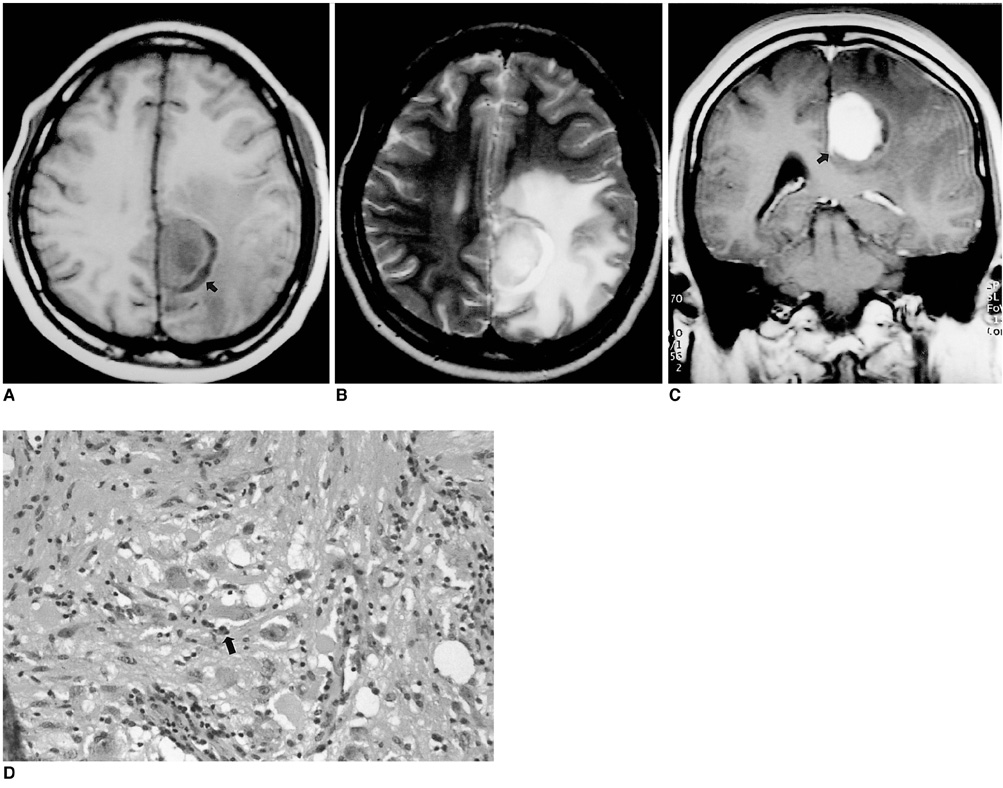Korean J Radiol.
2001 Jun;2(2):108-112. 10.3348/kjr.2001.2.2.108.
Gangliocytoma Mimicking Extra-axial Tumor: A Report of Two Cases
- KMID: 754113
- DOI: http://doi.org/10.3348/kjr.2001.2.2.108
Abstract
- We report two cases of supratentorial gangliocytomas mimicking an extra-axial tumor. MR imaging indicated that the tumors were extra-axial, and meningiomas were thus initially diagnosed. Relative to gray matter, the tumors were hypointense on T1-weighted images and hyperintense on T2-weighted images. On contrast-enhanced T1-weighted images, homogeneous enhancement was observed, while CT scanning revealed calcification in one of the two cases.
Keyword
MeSH Terms
Figure
Reference
-
1. Zulch KJ. Brain Tumours: Their Biology and Pathology. 1986. Berlin: Springer-Verlag;184.2. Furie DM, Felsberg GJ, Tien RD, et al. MRI of gangliocytoma of the cerebellum and spinal cord. J Comput Assist Tomogr. 1993. 17(3):488–491.3. Altman NR. MR and CT characteristics of gangliocytoma, a rare cause of epilepsy in children. AJNR. 1988. 9:917–921.4. Sherazi ZA. Gangliocytoma: magnetic resonance imaging characteristics. Singapore Med J. 1998. 39(8):373–375.5. Izukawa D, Lach B, Benoit B. Gangliocytoma of the cerebellum: ultrastructure and immunohistochemistry. Neurosurgery. 1988. 22:576–581.6. Kawamoto K, Yamanouchi Y, Suwa J, Kurimoto T, Matsumura H. Ultrastructural study of a cerebral gangliocytoma. Surg Neurol. 1985. 24:541–549.7. Peretti-Viton P, Perez-Castillo AM, Raybaud C, et al. Magnetic resonance imaging in gangliogliomas and gangliocytomas of the nervous system. J Neuroradiol. 1991. 18(2):189–199.8. Itoh Y, Yagishita S, Chiba Y. Cerebral gangliocytoma. An ultrastructural study. Acta Neuropathol. 1987. 74:169–178.
- Full Text Links
- Actions
-
Cited
- CITED
-
- Close
- Share
- Similar articles
-
- A Case of Acromegaly Caused by Mixed Gangliocytoma-Adenoma of the Pituitary Gland
- Supratentorial Anaplastic Ependymoma Mimicking an Extra-Axial Tumor: A Case Report
- Extra-Axial Medulloblastoma in the Cerebellar Hemisphere
- A Rare Case of Concomitant Intramedullary Gangliocytoma at the Cervicomedullary Junction in Patient with Neuroendocrine Tumor of Lung
- A Cerebral Astroblastoma Mimicking an Extra-axial Neoplasm



